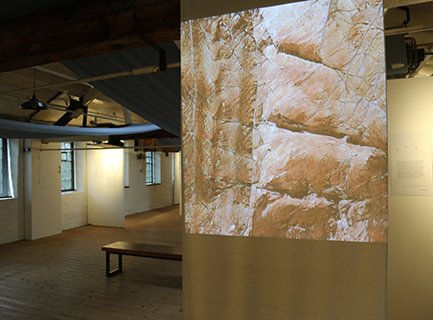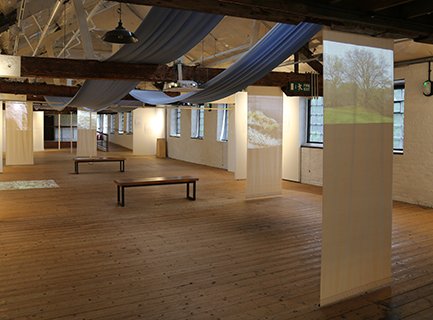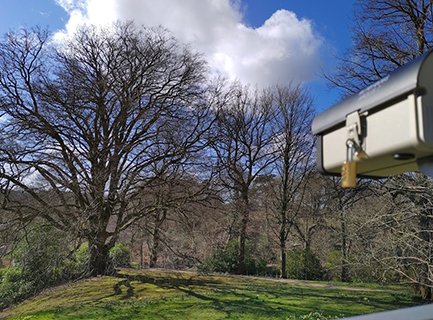Gathering Downstream
2022
Gathering Downstream is part of the Unintended Consequences program and was commissioned by FutureEverything for NT Quarry Bank, Cheshire.
Unintended Consequences, part of Trust New Art, the National Trust’s programme of contemporary arts, supported using public funding by Arts Council of England and produced with support from Arts&Heritage. Led by FutureEverything, with new commissioned work by artist Jen Southern.
The Great Beech - A timelapse video from May - Sept 2022
Machine Learning Videos trained with images from Quarry Bank landscapes and archives
Moss and Lichen and pages from a wages ledger
The rising and falling River and a 18th C textile pattern book
Meadow seeds growing and a mill production ledger
Red sandstone rocks & local maps
Participatory Machine Learning - using photographs of clothing taken during the exhibition
What can humans and machines learn about the impacts of climate crisis and ecological emergency from the trees, meadows, rocks, river, mosses and lichens at Quarry Bank?
Gathering Downstream is an artwork by Jen Southern that unfolds through five films created with machine learning technology. She has worked with Clare Brown, Katharine Cook, James Firth, Colin Gorner, Suzanne Kellett and Ally Tsilika at Quarry Bank to gather thousands of images from across the estate and archives to train this technology. Participants could also contribute photographs to collectively change future versions of the films, a form of 'participatory machine learning'.
The artwork explores the legacy and impact of the industrial revolution, and its often exploitative links with the surrounding landscape. The installation gathers together the movement of plants, rocks, people and machines, through their relationship to water, from the river and damp air that brought both mossy abundance and Samuel Greg (1759-1834) and his cotton mill to Quarry Bank, to the drought and flooding that are two of the biggest global impacts of the climate crisis.
In the films the human-made, machine-made and natural are interwoven, intimately entangled and inseparable. As they struggle to co-exist they are teeming with human and non-human life, and each could overwhelm the other. With their lives so closely connected, the work suggests an urgency to act now to care for our collective futures.
The videos in this exhibition were made with machine learning software (Runway ML) trained with thousands of images of Quarry Bank landscapes, archives and maps. What you see are not photographs, but images generated by the software. The videos combine natural features with reminders of past exploitative practices: records of production and profit, ledgers documenting names and low wages, a textile pattern book that was used to sell fabrics in North America and maps of land use from geology, tree cover and agriculture to the airport today. Looking over it all is a timelapse video, capturing the daily life of a beech tree that has been here since Samuel Greg arrived, witnessing everything from the industrial revolution to climate crisis.
250 Meadow Planting kits were given out through 6 planting demonstrations. The kit contained a biodegradable seed tray, peat free compost, a small paper envelope of meadow seeds similar to ones used to replant meadows on the Quarry Bank estate, and riso printed instructions using soy based biodegradable inks.
In the exhibition where possible we have: reused existing display cases, walls, projectors, and cameras, and used fabric made in museum demonstrations, paper rather than vinyl plastics for signage and biodegradable inks for printing.
This project has been underpinned by research from the University of Manchester - with archival research supported by the John Rylands Research Institute - with special thanks to:
Dr Joanne Tippett, Senior Lecturer in the School of Environment, Education and Development and co-creator of RoundView,
Fraser How, Co-creator of RoundView, How Creative
Jamie Farrington, PhD Researcher in History and Biological Sciences
Aneurin Merrill-Glover, PhD Researcher in History
Matthew Sanderson, PhD Researcher in Planning and Environmental Management

5 projections installed in the top floor of Quarry Bank Mill. A 'river' of blue fabric, made during machine demonstrations two floors below, weaves through the ceiling.

A machine learning model trained with macro photographs of textile patterns from the 1700's pattern book used by Samuel Greg's uncles to sell fabric to North America. The model was trained with images of the weir and the river that powers the looms.

The first frame of the video, woven by the machine learning software.

ML combinging water and weave

In flood and drought.

Custom built camera so that audiences can photograph the textiles that they're wearing and contribute to a participatory machine learning model, that will contribute to the following months videos.

A frame from the ML using participants fabrics. The close weave of the historical samples is gone, replaced by very different textures and a denimy colour.

The wrinkles of worn garments were also learned by the ML, and occasionally contemorarly colour choices come through.

The patterns and images on clothing from participants were never consistent enough for the ML to learn anythign recognisable. But it somehow started to make something that had a suggestion of peacock feathers.

It also developed other patterns, that almost try to repeat a series of spots.

The second projection is made with photographs of maps and rocks in the grounds of Quarry Bank Mill. It moves very slowly.

And rocks becoming maps start to look like human impressions on the landscape

The third video is made using hundreds of images of moss and lichen from QB and of the wages book. The ML clearly learns something like writing a name, so nearly readable. The mosses and lichens start to reproduce the lines of the ledger.


And the moss seems to grow over the meticulous records made in the late 1700's.

Moss and Wage book spliced together with machine learning

The fourth video uses hundreds of images of the production ledger with hundreds of stages of meadow seeds that I grew at home and photographed at every stage.

The grass seems to grow, but often takes on the grid of the ledger, almost mimicking the rows of seeds machine planted in agricultural fields.


The final video is a timelapse of the great beech tree at Quarry Bank, that is old enough to have been there when the mill was built.

Each month the video was updated with new growth from the tree.

The camera on the day I installed it

Go pro camera with timer, and solar panel.

A Riso printed map helped visitors to go out into the grounds to find the moss, lichen, meadows, tree, rocks and river that the show is made from.

We produced 250 meadow planting kits and gave them away so that people could learn about the biodiversity and flood management potential of meadows, and grow some seeds at home.

The packs contained sustainable materials: peat free coir soil, compressed paper seed trays, meadow seeds, paper packaging and non-toxic riso printed labels and instructions.